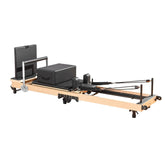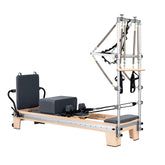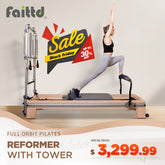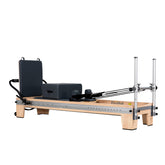Can You Lose Belly Fat From Reformer Pilates?
Quick Answer
Reformer Pilates alone won't spot-reduce belly fat, but it can help you lose fat overall by strengthening your core muscles, improving posture, and burning calories. For best results, combine regular Reformer sessions with proper nutrition and some cardiovascular exercise to create the calorie deficit needed for fat loss.
Introduction
Struggling with stubborn belly fat? Reformer Pilates might be your answer, strengthening your core, improving posture, and burning calories all at once. This specialized workout targets deep abdominal muscles while reducing stress-a hidden contributor to belly fat. But how effective is it really, and which exercises deliver the best results? Read on as we break down the science behind Reformer Pilates for belly fat reduction and reveal the specific moves that will transform your midsection.
What Causes Belly Fat?
Belly fat comes from many factors including biology, behavior, and environment that affect how your body stores extra energy.
- Two types of belly fat exist: subcutaneous fat (just under the skin) and visceral fat (around organs). Visceral fat is more dangerous for health.
- Visceral fat releases inflammatory proteins that increase the risks of heart disease, diabetes, and metabolic problems.
- Stress raises cortisol levels, which triggers cravings for unhealthy foods and directs fat storage to your belly area.
- What you eat affects where fat accumulates. High-fat meals can decrease fat storage under the skin but increase dangerous visceral fat.
- Hormones matter too. Men typically store more visceral fat while women store more subcutaneous fat until menopause.
- Genetics determine where your body naturally stores fat, making some people prone to belly fat regardless of their overall weight.
- Lifestyle choices like sitting too much, poor sleep, and drinking alcohol increase belly fat even without weight gain.
How Fat Loss Actually Works
Fat loss is a complex biochemical process with multiple metabolic pathways that break down stored energy when the body is in a caloric deficit.
- Fat loss begins with lipolysis, in which triglycerides stored in adipocytes (fat cells) are broken down into glycerol and fatty acids in response to hormonal cues induced by a caloric deficit.
- Hormone-sensitive lipase (HSL) and adipose triglyceride lipase (ATGL) are key enzymes regulating this process of breakdown, activated when insulin decreases and catecholamines increase.
- Secreted fatty acids must be delivered across the cell membrane by specialized protein carriers like fatty acid translocase (FAT) prior to entering into the bloodstream.
- Once in the bloodstream, fatty acids are bound to albumin for delivery to tissues where they can be oxidized (burned) for energy in the mitochondria through beta-oxidation.
- The ultimate oxidation of fatty acids is through the citric acid cycle and electron transport chain, ultimately producing ATP (energy) and carbon dioxide as a waste product.
- Fat mobilization is regulated by a number of hormones including insulin (which inhibits lipolysis), glucagon, erepinephrine, and norepinephrine (which activate lipolysis), so stress, sleep, and diet all have an important impact on fat mobilization.
- The respiratory exchange ratio (RER) informs us whether carbs or fats are being used predominantly for fuel, with low-intensity exercise tending to support fat oxidation.

Why Spot Reduction is a Myth
You can't burn fat from just one body area by exercising that spot. Science shows this doesn't work.
- Fat cells discharge stored fat into your bloodstream according to hormones that affect your whole body, not the individual area you are exercising.
- When you exercise, your body takes fat from your whole bloodstream, not just near the muscles you're exercising.
- Body scan research shows that doing ab exercises does not burn fat in your belly more than other fat - you burn fat throughout.
- Some exercises tone and build muscles, but the layer of fat above them is reduced only when you burn fat as a whole.
- Genes and hormones decide in which places you store fat and in what sequence your body burns fat while losing weight.
- Women tend to struggle with burning lower body fat because of particular receptors that combat fat breakdown, while men typically struggle with fat around the midsection.
- To lose fat, create a calorie deficit through better nutrition, cardio work, and strength training for your entire body - not specific areas of concern.
How Does Reformer Pilates Help with Belly Fat?
Reformer Pilates uses a special machine with springs and pulleys to create resistance during exercise. While no workout can target fat loss in just one area, this method offers several benefits that may help reduce belly fat when combined with other healthy habits.
1. Reformer Exercises Work Deep Stomach Muscles
Reformer Pilates targets deep abdominal muscles that regular exercises often miss. The moving platform forces you to stabilize your body, effectively engaging your entire core.
- Studies show it builds stronger abs than mat exercises alone, with visible results after 2-3 months of regular practice.
- The machine's resistance makes muscles work harder, creating better results for your midsection.
- Research confirms that certain reformer exercises work your abs just as well as traditional core workouts, but with less stress on your lower back.
2. You Burn Calories During Reformer Pilates
Though Pilates Reformes focuse on strength and flexibility, they also help burn calories:
- A typical 50-minute session burns 175-250 calories for a 150-pound person, with advanced workouts potentially burning over 400 calories.
- The workout intensity is similar to brisk walking or light cycling.
- Using the reformer machine burns 20-30% more calories than doing the same exercises on a mat.
- The workout may continue burning calories even after you've finished exercising.
3. Better Posture Makes Your Stomach Look Flatter
Better posture can make your stomach look flatter, even without losing fat:
- Regular practice improves spine alignment, reducing the curve in your lower back that can make your belly stick out.
- After just 12 weeks, studies show significant improvements in hip alignment, which directly affects how your midsection appears.
- Learning proper spine position and breathing strengthens the muscles that prevent your pelvis from tilting forward (which makes your stomach protrude).
- Better upper back mobility creates a taller posture that naturally elongates your torso, making your abdomen appear slimmer.

Additional Benefits of Reformer Pilates
More Muscle Burns More Calories Even When Resting
Reformer Pilates creates lean muscle throughout your body that can increase your metabolism:
- Each pound of muscle burns 6-10 extra calories a day, even when you are at rest. Adding just 2-3 pounds of muscle can cause you to burn more calories during the day.
- Reformer resistance training maintains muscle mass as you age, staving off the natural metabolic slowdown that comes with aging.
- Reformer Pilates lengths and slim muscles to boost metabolism without bulk, as opposed to heavy-weight training.
- Reformer workouts are full-body in scope, so you're working multiple muscle groups at once, which maximizes your metabolic return in less time.
Less Stress Means Less Belly Fat
Reformer Pilates can significantly decrease stress, which avoids stress-induced weight gain:
- The focused breathing that is involved in Reformer Pilates lowers cortisol (the stress hormone), which is linked to excess abdominal fat when levels are consistently high.
- As few as 8 weeks of regular practice has been shown to lower anxiety and improve mood in research.
- The mindful movement approach soothes your nervous system, switching your body out of "fight or flight" mode and into "rest and digest" mode.
- Better sleep is experienced by many after Reformer Pilates sessions, which is significant since poor sleep is linked to weight gain and hunger.
Better Overall Fitness Makes Weight Control Easier
Reformer Pilates improves multiple aspects of fitness that work together to help manage weight:
- It increases flexibility and range of motion, making everyday activities and other exercises easier to perform.
- The balanced approach improves both strength and endurance, helping you stay active longer during the day.
- Better coordination and balance from regular practice reduces injury risk, keeping you consistent with your fitness routine.
- Many people find Reformer Pilates more enjoyable than traditional workouts, making them more likely to stick with it long-term-the key to any successful fitness program.
Common Misconceptions About Reformer Pilates and Fat Loss
1. Pilates Alone Will Melt Fat
Reformer Pilates will not transform your body and burn fat by itself. While it develops excellent core strength and corrects posture, it burns 250-400 calories per session. This will not reduce fat without dietary modifications. Reformer exercise is great in that it addresses muscle imbalances and creates functional strength, which can be a springboard to more intense exercise. It works best as an addition to cardio training and nutrition, not as a stand-alone fat-loss program.
2. Results Happen Overnight
Major body changes don't happen after 3 Pilates sessions. Realistic timeframes are: better posture and energy within 2-3 weeks, visible muscle tone within 6-8 weeks, and marked changes in body composition within 10-12 weeks. The outcome is based on consistent practice and proper diet. Highlight tracking of functional gains (better movement, balance, flexibility) rather than appearance changes as performance gains will likely come before noticeable body changes.
3. Exercise Alone Is Enough
You can't practice Reformer Pilates and ignore sleep, stress, and diet and expect to achieve maximum gains. Stress hormones like cortisol lead to the storage of belly fat, poor sleep impairs healing and recovery, and eating close to exercise has a significant effect on body composition. A holistic approach to wellness that considers all methods of living will have much better results than exercise alone. Pilates works best when done as part of an overall healthy lifestyle.

Is Reformer Pilates Right for Everyone?
Beginners vs. Pros
Reformer Pilates welcomes beginners who are:
- Those intimidated by exercise equipment - the Reformer provides guidance and support
- People needing form correction - the machine helps you move correctly
- Individuals with limited strength - resistance can be adjusted to very low
- Those requiring extra support while learning movements
Reformer Pilates might not be the best fit for beginners who:
- Prefer completely independent exercise without equipment
- Have severe anxiety about using unfamiliar machines
- Need extremely low-cost workout options (Reformer sessions typically cost more than mat classes)
Experienced exercisers will appreciate Reformer Pilates when they are:
- Fitness enthusiasts seeking greater challenges - springs can be reduced for instability
- Those ready for complex movements and advanced exercises
- Athletes looking to correct muscle imbalances from sport-specific training
- People wanting to progress to jumping and standing Pilates work
Advanced fitness enthusiasts might look elsewhere if they:
- Exclusively want high-intensity, high-impact workouts
- Prefer training that focuses on isolated muscle building rather than functional movement
Matching the Reformer to Your Goals
Reformer Pilates excels as rehabilitation for:
- Those recovering from injuries - springs provide gentle, controlled resistance
- People with joint issues - the sliding carriage reduces the impact
- Individuals rebuilding strength after surgery or illness
- Those needing to improve mobility with support
Consider alternatives to Reformer Pilates for rehabilitation if:
- You require specialized medical equipment beyond what Pilates offers
- Your condition requires only passive treatment approaches
Reformer Pilates delivers strength benefits for:
- Those wanting functional strength through full-body movements
- Sport-specific athletes (golfers, runners, swimmers) targeting performance improvements
- People seeking balanced muscle development rather than bulk
- Individuals wanting to improve core strength and stability
Look beyond Reformer Pilates for strength training if:
- Your primary aim is significant muscle hypertrophy or maximum strength gains
- You're focused exclusively on power lifting or explosive movements

Top Reformer Pilates Weight Loss Questions Answered
Q1: How often should I do Reformer Pilates to see results?
For optimal effect, have 2-3 Reformer Pilates sessions a week. This provides your body with sufficient stimulus for building strength with time to recover between sessions. Most individuals feel enhanced posture and engagement of the core after 3-4 sessions, but a noticeable change to your body shape takes about 8-12 regular sessions (one month). For dramatic body transformation, keep practicing regularly for at least 3 months.
Q2: Can Reformer Pilates replace cardio for fat loss?
Reformer Pilates shouldn't completely replace cardio if fat loss is your goal. While Pilates builds muscle and improves metabolism, it typically burns 300-400 calories per hour-less than most cardio workouts. For effective fat loss, combine Reformer Pilates (2-3 times weekly) with cardio exercises like walking, swimming, or cycling (2-3 times weekly). This combination burns calories while building the lean muscle that helps reshape your body.
Q3: Is Reformer Pilates effective for weight loss?
Reformer Pilates supports weight loss as part of a comprehensive approach but isn't a quick fix by itself. It helps weight loss by:
- Building lean muscle that increases your resting metabolism
- Improving posture which creates a more streamlined appearance
- Strengthening your core and developing body awareness
- Reducing stress which can decrease stress-related eating
For effective weight loss, pair Reformer Pilates with proper nutrition and some form of cardiovascular exercise.
Q4: Do I need a special diet to lose belly fat with Pilates?
No special diet is required, but nutrition matters significantly for belly fat reduction. Since no exercise can spot-reduce fat, focus on overall healthy eating habits:
- Achieve a moderate calorie deficit (250-500 calories less than your maintenance calories)
- Include lots of protein (preserves the muscle as you lose fat)
- Munch on fiber-packed vegetables and fruits
- Opt out of processed foods, added sugars, and alcohol
- Drink plenty of water
Remember that Reformer Pilates builds the muscles under your belly fat, but dietary changes help reveal those muscles by reducing the fat layer.
Q5: Can Reformer Pilates help with long-term fat loss?
Yes, Reformer Pilates supports long-term fat loss in several important ways:
- Builds lean muscle that increases your resting metabolism
- Builds healthy exercise habits you can maintain for years
- Improves posture and body awareness that carries over to daily activities
- Makes other exercises more enjoyable and effective as they work out your core
- Provides increasingly challenging workouts that you stay engaged with as you get better
Unlike quick-fix approaches, Reformer Pilates builds a foundation of strength and body awareness that supports healthy weight maintenance for life.
Read More
- What is the Pilates Reformer? Benefits, Techniques, and Usage
- Is 20 Minutes of Pilates on the Reformer a Day Enough?
- Pilates Reformer 101: A Step-by-Step Guide for Newbies
- Incorporate the Pilates Reformer into Existing Fitness Routine
- Advanced Pilates Reformer: Build Muscle & Strength Today
- Prevent Injuries & Rehabilitate with Pilates Reformer Now





